A Victorian Christmas
by Pearl Harris
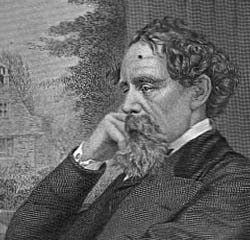 On
December 18, 1988, Britain's Sunday Telegraph proclaimed Charles
Dickens as "the man who invented Christmas." And it is surely
true that no other writer has left the world with a clearer
picture of Christmas in Victorian England than Dickens. On
December 18, 1988, Britain's Sunday Telegraph proclaimed Charles
Dickens as "the man who invented Christmas." And it is surely
true that no other writer has left the world with a clearer
picture of Christmas in Victorian England than Dickens.
Dickens might not have invented Christmas, but he is
credited with the great revival of Christmas traditions in the
Victorian era, which have continued in one form or the other to
the present day in all English-speaking countries around the
globe.
Dickens was born in 1812 in Portsmouth, and his childhood was far
from easy, coming as he did from a large family with rather
unconventional parents. From his mother, Elizabeth, he inherited
a keen sense of the ridiculous. The disastrous financial
affairs of John, his father, resulted in the young Charles being
put to work at the age of 12 and the entire family, except for
Charles and one sister, being incarcerated in a Debtors Prison.
For someone whose formal education ended at such a tender age,
the eternal magic and genius of his prose seem nothing short of
the miraculous.
Out of his five Christmas Books, A Christmas Carol
(published on 17 December, 1843) is surely one of his best-loved
works. The uplifting tale of the heartless miser Ebenezer
Scrooge and his reform at Christmas time have been immortalized
in countless film and theatrical productions.
Just as A Christmas Carol profoundly influenced Victorian
readers, its simple message of love, goodness and charity
continues to touch modern readers in the same way. However, A
Christmas Carol is not only an uplifting moral tale, but one
of great historical importance due to Dickens' brilliant, witty
and detailed description of a Victorian Christmas.
From its pages we are able to soak in the atmosphere of a cold,
frosty Christmas Eve. Workers scurry home with the eager
anticipation of a rare day off work. Shopkeepers close up their
shutters. Fires are lit in hearths throughout the country.
Families, both poor and wealthy, gather around the Christmas tree
("That pretty German toy", as it is referred to by Dickens).
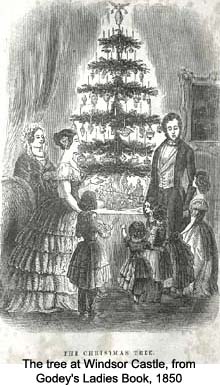 The Christmas Tree tradition began in the
Victorian era, with the custom of a lighted evergreen
(Tannenbaum) originating in Germany. German-born Prince
Albert, Consort of Queen Victoria, brought the idea to England
and by the mid-19th century, Christmas Trees at Windsor Castle
were decorated with wax candles and laden with presents. As
citizens copying the Royal tradition spread this custom, the
Christmas Tree soon became a popular English tradition. The Christmas Tree tradition began in the
Victorian era, with the custom of a lighted evergreen
(Tannenbaum) originating in Germany. German-born Prince
Albert, Consort of Queen Victoria, brought the idea to England
and by the mid-19th century, Christmas Trees at Windsor Castle
were decorated with wax candles and laden with presents. As
citizens copying the Royal tradition spread this custom, the
Christmas Tree soon became a popular English tradition.
It was (and still is) considered bad luck to remove the Christmas
Tree and other Christmas decorations before Twelfth Night (6th
January). Superstition stated that it was also bad luck to put
up a Christmas Tree before Christmas Eve, although other
Christmas decorations might appear some time before
Christmas. The mistletoe, holly and ivy were considered
magical plants because of their winter berries. Mistletoe, with
its pagan origin, was not allowed inside churches. The English
custom of kissing under the mistletoe had the restriction that
there could only be as many kisses as berries. Every time a
couple kissed beneath the mistletoe, a berry was to be removed
from the sprig. Holly was used as a decoration and also
to decorate the Christmas Pudding. The red "male" berry was
meant to protect the household from witchcraft and could only be
brought into the home by a male. The "female" ivy, with its
leaves that remained green throughout the winter, was a symbol of
immortality. Some time before Christmas, Christmas cards
were mailed. The first Christmas card was designed in 1846 by J.
Calcott Horsley for Sir Henry Cole, Chairman of the Society of
the Arts. In that first year, a mere 1000 cards were printed.
By 1870, with postage reduced to one penny per ounce and cheaper
color lithography having been introduced, the popularity of
sending friends and family members Christmas cards rapidly
increased. The most common designs of Victorian Christmas cards
were plum puddings and church bells.
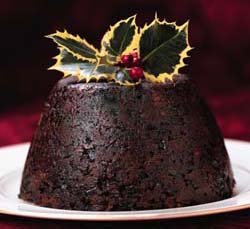 Prince Albert imported many other German Christmas
traditions besides the tree. As he was particularly partial to
rich pudding, the flamed Christmas Pudding was given Royal pride
of place at Christmas, beside German cookie-cutter cookies and
gingerbread. Prince Albert imported many other German Christmas
traditions besides the tree. As he was particularly partial to
rich pudding, the flamed Christmas Pudding was given Royal pride
of place at Christmas, beside German cookie-cutter cookies and
gingerbread.
Dickens describes the streets of London
with its shops gaily decorated with sprigs of Holly and Christmas
Day as being the one day off work in the year. On Christmas Eve,
Scrooge grumbles to his clerk as he reluctantly gives him the
following day off: "A poor excuse for picking a man's pocket
every twenty-fifth of December! But I suppose you must have the
whole day. Be here all the earlier next morning".
The
Victorian custom of carol-singing on Christmas Eve and Christmas
Day is also given life by Dickens thus: Scrooge was too miserly
to open his door to any carolers, so one young caroler "stooped
down by Scrooge's keyhole to regale him with a Christmas Carol.."
and was given short shrift! Carols were also sung at home, with
some families going from door to door singing. The wassailers
were usually the poor, who offered others a drink from their
wooden bowls and expected donations of food, drink or money in
return.
We soak in the wintry atmosphere of Christmas Eve as Dickens
writes of the bitter cold, frost and fog in the streets of London
in contrast to the cozy fires burning in the hearths of most
homes as families gather together to celebrate Christmas.
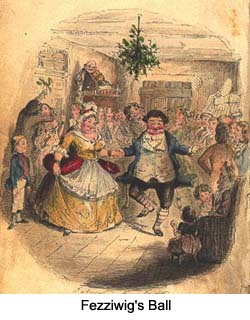 In many Victorian firms, it was customary for employers to
entertain employees and apprentices on Christmas Eve. Dickens
vividly describes one such "Domestic Ball" in a warehouse: "lamps
were trimmed, fuel was heaped upon the fire; and the warehouse
was as snug, and warm, and dry, and bright a ball-room as you
would desire to see upon a winter's night." The employees are
entertained by a fiddler, they dance, eat cake, cold roast and
mince pies and drink beer and negus" (hot, spicy mulled
wine). In many Victorian firms, it was customary for employers to
entertain employees and apprentices on Christmas Eve. Dickens
vividly describes one such "Domestic Ball" in a warehouse: "lamps
were trimmed, fuel was heaped upon the fire; and the warehouse
was as snug, and warm, and dry, and bright a ball-room as you
would desire to see upon a winter's night." The employees are
entertained by a fiddler, they dance, eat cake, cold roast and
mince pies and drink beer and negus" (hot, spicy mulled
wine).
In addition to negus, common drinks at Christmas were various
kinds of Gin Punch, including Purl (heated beer, flavored with
gin, sugar and ginger) and Bishop (a Punch made with heated red
wine, flavored with oranges, sugar and spices).
The Victorian Christmas was a merry, joyous, family celebration
with "the brightness of the roaring fires in kitchens, parlors,
and all sorts of rooms". Again, in Dickens's unique prose: "Here,
the flickering of the blaze showed preparations for a cozy
dinner, with hot plates baking through and through before the
fire, and deep, red curtains, ready to be drawn to shut out cold
and darkness. There, all the children of the house were running
out into the snow to meet their married sisters, brothers,
cousins, uncles, aunts, and be the first to greet them."
Christmas Day was celebrated with Mass, heralded by the peal of
Church bells. "But soon the steeples called good people all to
church and chapel, and away they came, flocking through the
streets in their best clothes, and with their gayest faces". The
traditional Christmas Church service consisted of carol-singing
and scripture readings.
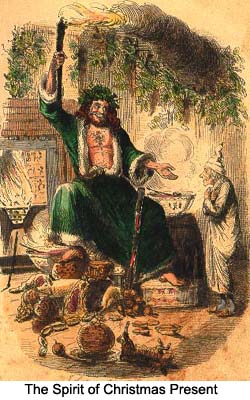 Christmas Dinner was a
sumptuous occasion. Turkey was not traditionally served in
England until the late 19th century. Instead goose, chicken or
roast beef took pride of place on the Christmas table, followed
by Christmas Pudding made from beef, raisins and prunes. Christmas Dinner was a
sumptuous occasion. Turkey was not traditionally served in
England until the late 19th century. Instead goose, chicken or
roast beef took pride of place on the Christmas table, followed
by Christmas Pudding made from beef, raisins and prunes.
Mince Pies -- made with mincemeat and spices -- were also
traditional Christmas fare and were eaten for the 12 days of
Christmas, ensuring good luck for the next 12 months of the year.
According to custom, each of the twelve mince pies had to be
baked by someone different.
Even in humbler households, Christmas Dinner was a very special
occasion, with a goose, apple sauce and mashed potatoes followed
by Christmas Pudding being enjoyed by the poor Cratchit family.
It was common for the poor family without proper cooking
facilities to carry their Christmas dinners to the baker's shops
to be cooked at Christmas. Dickens mentions this custom: "And at
the same time there emerged, from scores of by-streets, lanes,
and nameless turnings, innumerable people carrying their dinners
to the bakers' shops".
The Sunday before Advent, known as Stir-up Sunday, was the day to
mix the Christmas Pudding so that it could be well matured by
Christmas Day. Each family member had to take it in turns to
stir the Pudding with a wooden spoon (to honor the wooden crib of
the Christ Child). Stirring was to be done clockwise to ensure
good luck! As Mrs. Cratchit proudly carries in the Christmas
Pudding, the importance of this once-a-year treat is highlighted
by Dickens:
"A great deal of steam! The pudding was out of the copper. A
smell like a washing-day! That was the cloth. A smell like an
eating-house and a pastry cook's next door to each other, with a
laundress's next door to that! That was the pudding! In half a
minute Mrs. Cratchit entered -- flushed, but smiling proudly --
with the pudding, like a speckled cannon-ball, so hard and firm,
blazing in half of half-a-quartern of ignited brandy, and bedight
with Christmas holly stuck into the top. O, a wonderful
pudding!"
After Christmas dinner, the poor Cratchit family settles down
around their hearth, enjoying together some fruit, hot negus and
chestnuts roasted on the fire. In more prosperous families,
Christmas dinner usually ended with gift-giving and pulling of
Christmas Crackers (an invention in 1847 by the Londoner Tom
Smith). The day would be rounded off with music, carol-singing
and parlor games such as Forfeits and Blind Man's Buff.
At Christmas, it would be most appropriate for us all to heed the
immortal wisdom of Charles Dickens as penned in the 1850
Christmas issue of Household Words:
"And I do come home at Christmas. We all do, or we all
should. We all come home, or ought to come home, for a short
holiday -- the longer, the better -- from the great
boarding-school, where we are for ever working at our
arithmetical slates, to take, and give a rest. As to going a
visiting, where can we not go, if we will, where have we not
been, when we would, starting our fancy from our Christmas Tree!"
More Information:
We regret that we no longer have the resources to maintain up-to-date links and/or hours and pricing details for the various sites and attractions listed on this website. For more information about the location(s) listed above, please use your favorite search engine or visit Wikipedia.
Pearl Harris, whose ancestors hail from Britain, was born in South Africa, where she lived for most of her life until emigrating to the Czech Republic in 2002 with her husband, their dog and cat. She is now a teacher of English as a second language and freelance travel writer. Pearl has travelled extensively in Africa, Europe, the USA and Britain. Recently she undertook a car journey through England and Northern Ireland, visiting major sites of historical interest. Her main interests are travel, photography, reading and writing. Besides a qualification as a Diagnostic Radiographer, Pearl has a B.A. in English and Linguistics and post-graduate Diploma in Translation.
Article © 2005 Pearl Harris
Plum Pudding photo courtesy of BritainOnView.com
|
